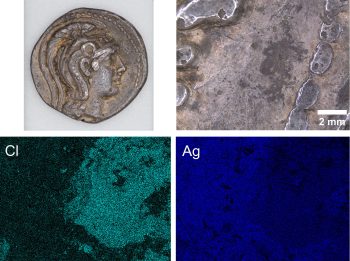
PREV ARTICLE
NEXT ARTICLE
FULL ISSUE
PREV FULL ISSUE
ROYAL ONTARIO MUSEUM'S ROMKOMMA PROJECTA project connected to the Royal Ontario Museum's ancient Greek coin collection is studying environmental degradation to guide conservation efforts. -Editor One of the ancient Greek coins from the ROM's collection analyzed at OCCAM (top left). A zoomed-in view of a section of the coin showing a corrosive product (top right). SEM-EDS maps of the section of the coin. The analysis suggests the nature of the corrosion product is silver chloride (bottom left and right). Researchers at the Open Centre for the Characterization of Advanced Materials (OCCAM) are working with the conservation team at the Royal Ontario Museum (ROM) to help preserve links to the past, ensuring important historical artifacts can be studied and shared with generations to come. Maria Stanko (MSE 2T2 + PEY, MSE PhD candidate) and her collaborators are studying the surfaces of two corroded Greek coins from the Hellenistic period, dating back to 300-115 BCE, using OCCAM's instrumentation. By understanding what is happening to these priceless relics, the team will be equipped to advise researchers and conservators on how to best conserve and store these artifacts safely. The coins are subjects of study for the ROMkomma project, a collaboration funded by the Social Sciences and Humanities Research Council and led by Professors Kate Cooper (UTSC Historical and Cultural Studies), a research associate at the ROM, and Ben Akrigg (Classics). The project aims to catalogue and publish data on the ROM's extensive collection of ancient Greek coins, which contains more than 2,000 coins. This investigation, which will make the ROM's Greek coin collection accessible online, could reveal important insights on early minting practices and how early economies were developed.
She and her colleagues, including Dian (Jack) Yu (MSE 2T1, MSE PhD candidate) and Dr. Michel Haché (MSE PhD 2T3), an MSE postdoctoral fellow, along with Stanko's PhD co-supervisor Professor Jane Howe (MSE, ChemE), developed a strategy to examine the coins with a scanning electron microscope paired with energy-dispersive X-ray spectroscopy (SEM-EDS).
To read the complete article, see:
For more information, see:
Wayne Homren, Editor The Numismatic Bibliomania Society is a non-profit organization promoting numismatic literature. See our web site at coinbooks.org. To submit items for publication in The E-Sylum, write to the Editor at this address: whomren@gmail.com To subscribe go to: https://my.binhost.com/lists/listinfo/esylum All Rights Reserved. NBS Home Page Contact the NBS webmaster 
|

